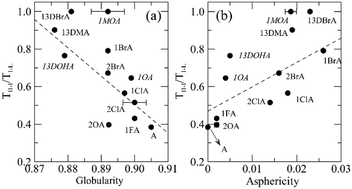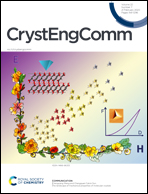Polymorphism of 1,3-X-adamantanes (X = Br, OH, CH3) and the crystal plastic phase formation ability†
Abstract
The polymorphism of 1,3-dimethyladamantane (13DMA), 1,3-adamantanediol (13DOHA) and 1,3-dibromoadamantane (13DBrA) has been studied by X-ray powder diffraction, density measurements and differential scanning calorimetry at normal and high-pressure. 13DMA exhibits a low-temperature ordered monoclinic phase (space group P21/c, Z = 4, Z′ = 1) which transforms at 222.6 ± 0.5 K into a high-temperature hexagonal plastic phase (P63/mmc, Z = 26), stable up to the melting point at 246.8 ± 0.5 K at normal pressure. 13DOHA exhibits a low-temperature hexagonal phase (P63/mcm, Z = 6, Z′ = 0.25) which transforms into a face-centered cubic plastic phase (Fm![[3 with combining macron]](https://www.rsc.org/images/entities/char_0033_0304.gif) m). 13DBrA exhibits a unique ordered orthorhombic phase (Pnma, Z = 4, Z′ = 0.5) which remains till the melting point at 382.1 ± 0.5 K. The stability temperature domain of the plastic phases increases with pressure for both 13DMA and 13DOHA. The ability to form the plastic phase for these compounds as well as a series of adamantanes derivatives is analysed through the globularity and asphericity parameters derived from the Hirshfeld surface analysis.
m). 13DBrA exhibits a unique ordered orthorhombic phase (Pnma, Z = 4, Z′ = 0.5) which remains till the melting point at 382.1 ± 0.5 K. The stability temperature domain of the plastic phases increases with pressure for both 13DMA and 13DOHA. The ability to form the plastic phase for these compounds as well as a series of adamantanes derivatives is analysed through the globularity and asphericity parameters derived from the Hirshfeld surface analysis.



 Please wait while we load your content...
Please wait while we load your content...